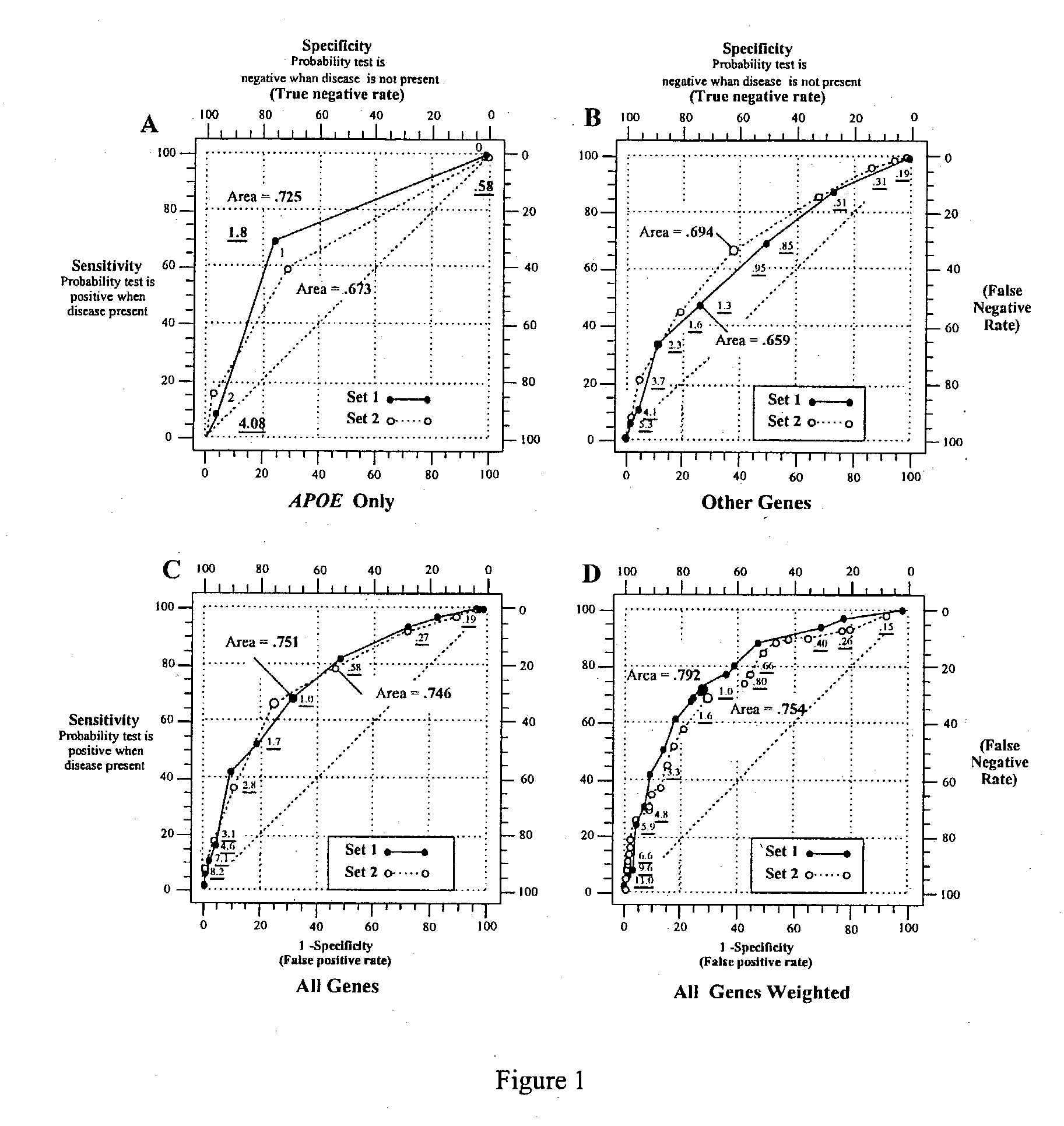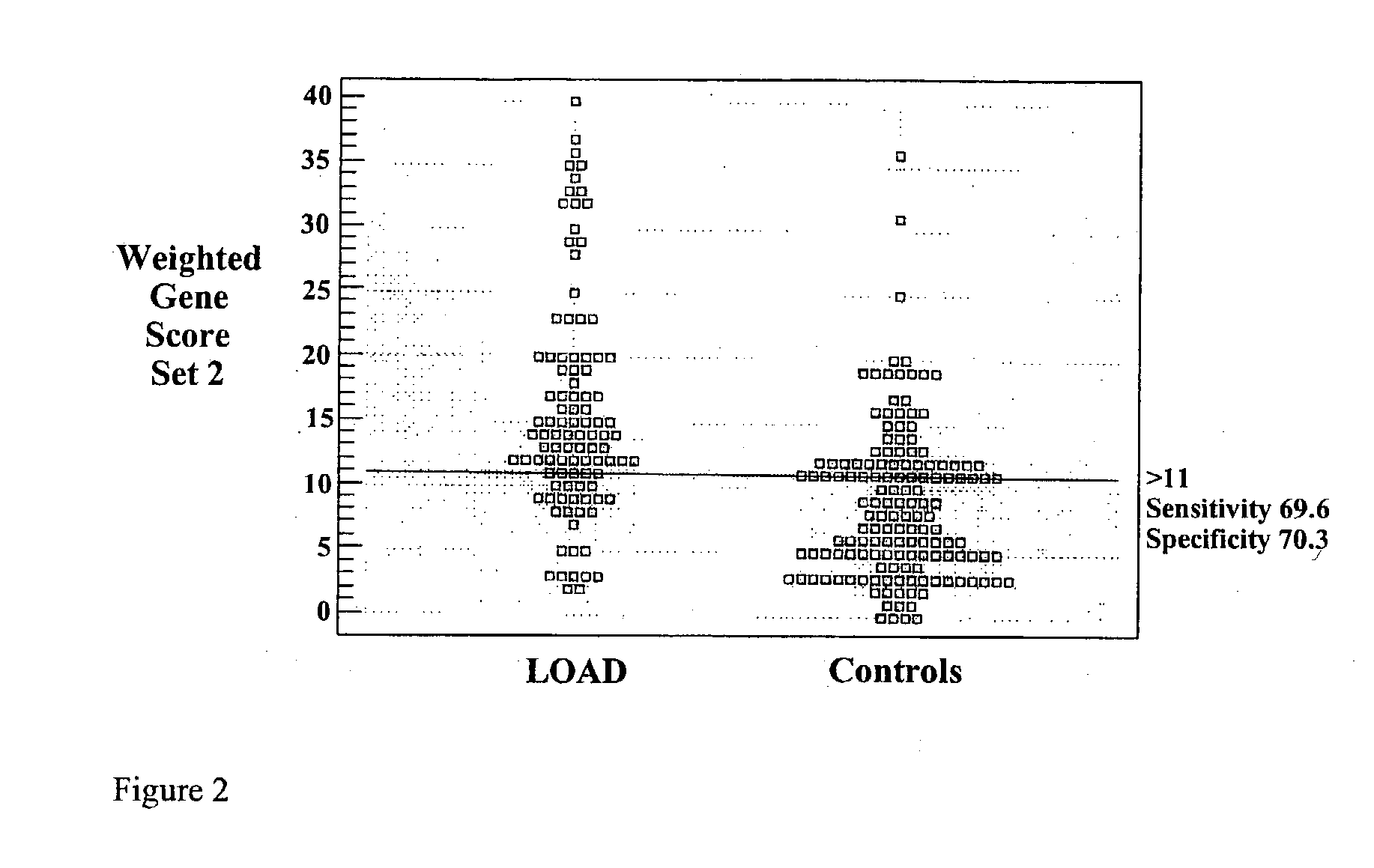Multi-gene tests with ROC plots for the assessment of risk for polygenic disorders
a polygenic disorder and multi-gene technology, applied in biochemistry apparatus and processes, instruments, instruments, etc., can solve the problems of poor replication between studies, lack of power to identify most polygenic genes, and dramatic weakening of tdt technique compared to case-control studies
- Summary
- Abstract
- Description
- Claims
- Application Information
AI Technical Summary
Problems solved by technology
Method used
Image
Examples
example i
[0079] Examination of Individual Genes with LOAD. The comparison of set 1 and set 2 is shown in Table 1. There were a total of 296 controls and 204 LOAD subject, with 250 individuals in each set for a total of 500 individuals in the study. The number of controls and LOAD cases in the two sets was identical and the mean age and sex ratio for the two sets was virtually identical. Although the mean age of the LOAD subjects was greater than that of the controls, since our LOAD subjects came from a brain bank their age is their age at death. By contrast the controls are still living. We suspect that if the controls were followed until death and that was used instead of current age, the ages of the two samples would be more similar. However, some of the controls could have developed LOAD during that time and our results (see below) are consistent with the presence of some potential LOAD cases in the control group.
[0080] The results of the association of each gene with LOAD in set 1, set 2...
example ii
[0105] Ad Scores
[0106] AD+control samples were genotyped at APOE, ESR1, SLC6A4, ACE and ACP1A. The genotypes were placed into three genotype groups. For bi-allelic SNPs these groups were 11, 12 and 22. For the APOE e2-4 polymorphism the genotypes consisted of 4 / 4 homozygotes, 4 / other heterozygotes, and non4 / non4 subjects. For the SLC6A4 sertrans polymorphism the genotypes were 12 / 12 homozygotes, 12 / non12 heterozygotes, and non12 / non12 homozygotes. For the remaining genes the three genotypes were 11, 12 and 22. The three genotypes of each gene / polymorphism set were examined by ANOVA against an AD score, which was scored as controls=0 and AD cases=1. These results are shown in Table 4 and are presented several ways. First, the mean AD score and standard deviation for each genotype are given. Second the F-ratio and p value for the ANOVA for the three genotypes are shown. Third, an F-ratio (F.sub.L-ratio) and p value (P.sub.L is given for the linear ANOVA results. If the given gene / poly...
example iii
[0124] Multi Gene Predictive Test for a Polygenic Disorder.
[0125] The present invention provides new techniques which incorporate the unique characteristics of polygenic disorders. In a preferred embodiment, the technique comprises the following approach:
[0126] 1. Accumulate a set of candidate genes and their respective polymorphisms that have been shown to be associated with the phenotype in question in at least one, and preferably several, but not necessarily all studies;
[0127] 2. Genotype a number of subjects expressing the trait, disease or disorder and a number of controls not expressing the trait, disease or disorder at each of these genes;
[0128] 3. Determine the score (in a preferred embodiment 0, 1 or 2) for each genotype;
[0129] 4. determining a combined relative risk score based on adding together relative risk scores for the genes determined by the logistic regression analysis to continue to contribute to the polygenic trait, disease or disorder; and
[0130] 5. examining the...
PUM
| Property | Measurement | Unit |
|---|---|---|
| pH | aaaaa | aaaaa |
| temperatures | aaaaa | aaaaa |
| temperatures | aaaaa | aaaaa |
Abstract
Description
Claims
Application Information
 Login to View More
Login to View More - R&D
- Intellectual Property
- Life Sciences
- Materials
- Tech Scout
- Unparalleled Data Quality
- Higher Quality Content
- 60% Fewer Hallucinations
Browse by: Latest US Patents, China's latest patents, Technical Efficacy Thesaurus, Application Domain, Technology Topic, Popular Technical Reports.
© 2025 PatSnap. All rights reserved.Legal|Privacy policy|Modern Slavery Act Transparency Statement|Sitemap|About US| Contact US: help@patsnap.com



